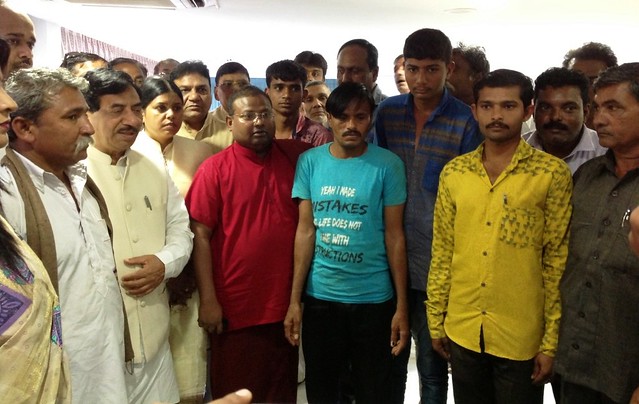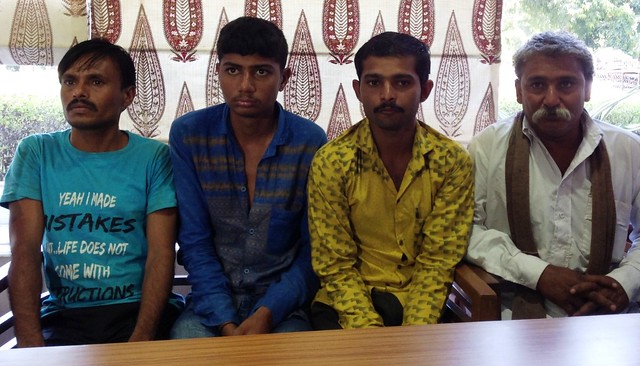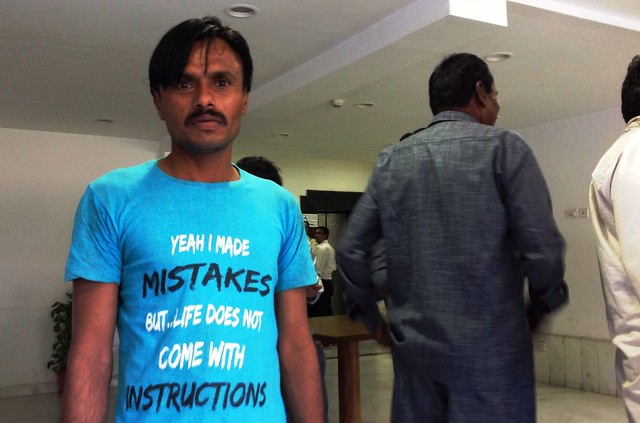By Amit Kumar and Afroz Alam Sahil, Twocircles.net
On July 11, four Dalits were publicly stripped and beaten up by Gau Rakshaks in Una in an event that shocked the nation and brought Gujarat to a standstill.
Three months later, even as Dalits in Gujarat continue with their demands, the same four people were ‘presented’ in front of the press at the Gujarat Bhawan by veteran BJP leader Satyanarayan Jatiya and Sanghpriya Rahul, the national president of Bharatiya Bauddha Sangh-the RSS affiliate organisation.

In what can be considered as a major achievement for the RSS family, the four were presented as a ‘symbol’ for Dalit Chetna Yatra that starts from October 14 in Delhi. The Yatra, which in its first stage will visit all 75 districts of UP, will also visit Bihar, Madhya Pradesh, West Bengal etc before culminating in June 2017 in Gujarat.
“We condemn the attacks on Dalits in the strongest terms possible. Even after 70 years of Independence, the condition of the Dalits in this country remains pretty bad, and this Yatra will seek to unite Dalits across the nation. We are ready to fight the long and hard battle for Dalits in this nation,” Rahul announced in front of the media.
Although the duo of Jatiya and Rahul insisted that this had nothing to do with the BJP or the RSS, it is also pretty clear that this is a last-ditch attempt by the BJP to appease Dalits in the region. Interestingly, the state they chose to begin with was UP even though the incident occurred in Gujarat, which is understandable given that a little over a quarter of UP’s population consists of Dalits, and like Gujarat, it too will see elections in 2017.
More importantly, apart from Jatiya and Rahul, the other important faces of the Yatra consist of Indresh Kumar, national executive member of the RSS, Ramvilas Paswan, Republican Party of India member of Minister for Social justice Ramdas Athawale among others. When asked how this was not a political move given the people participating in it, Rahul said, “We have made an appeal to everyone, and these people lent their support. They may be members of the BJP, but they are citizens of India first and they care about the plight of Dalits in this country.”
This press conference was also a way to counter the ongoing agitations in Gujarat, led by Una Dalit Atyachar Ladak Samiti and its leader Jignesh Mewani. The duo of Rahul and Jatiya went to great lengths to show that the correct and desired action had been taken by Narendra Modi and the BJP government, with Jatiya even saying that Una attack was the reason for the dismissal of Anandiben Patel as the Chief Minister of the state.
He said that the PM’s statement “If you have to shoot, shoot me, but not my Dalit brothers” had instilled confidence among the Dalits of the country. When asked how this was the case when attacks on Dalits had increased in the country in recent times, he refused to substantiate his claim.

Rahul also said that the demand of the UDALS-five acres of land to each Dalit household and a vow to never touch dead cattle again-was not the right thing to do. “If they stop doing this (picking dead cattle) how will they earn money? Then, the work will be done on the basis of tender and even if they get work, they will earn lesser,” he said. “The question of five acres of land is also not feasible…how will the land be distributed? What will be the basis of such a distribution? It is a nice idea, but the reality is different,” he said.

Interestingly, both Jatiya and Rahul maintained that they had no issues with Gau Rakshaks, at least the ‘good’ ones. When asked how they defined the ‘good’ Gau Rakshaks, Rahul said, “The ones who take care of the cows in the Gaushala”. Also, the moment this correspondent asked if they would also seek to address Muslims, who have suffered the most because of Gau Rakshaks, Rahul said, “we are deviating from the core issue here. Let us stick to Dalits.”
What happens over the next few days with regards to the Dalit Chetna Yatra remains to be seen; but it is clear that the BJP has turned the tables on the Gujarat agitation by bringing in its fold the same people who became symbols of protest against it.
